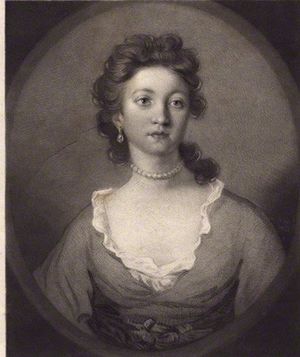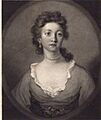Elizabeth Johnson (pamphleteer) facts for kids
Quick facts for kids
Elizabeth Johnson
|
|
|---|---|

Elizabeth Johnson by Samuel William Reynolds
|
|
| Born |
Elizabeth Reynolds
8 July 1721 Plympton, Devon, England
|
| Died | 14 May 1800 Great Torrington, Devon, England
|
| Occupation | Pamphlet writer |
| Spouse(s) | William Johnson |
| Children | 7 |
| Parents |
|
Elizabeth Johnson (born Elizabeth Reynolds; 8 July 1721 – 14 May 1800) was an English writer. She is known for trying to win a special prize offered by the British government. This prize was for anyone who could find a simple and accurate way to figure out a ship's longitude at sea.
Elizabeth Johnson and another woman named Jane Squire were the only two women known to have tried for this prize. At the time, it was very unusual for women to be involved in such scientific, financial, or government-related challenges.
Contents
Elizabeth Johnson: Solving the Longitude Puzzle
Her Early Life
Elizabeth Johnson was born in Plympton, Devon, England. Her parents were Reverend Samuel Reynolds and Theophilia Reynolds. She had several talented siblings.
One of her brothers was the famous artist Sir Joshua Reynolds. He even used Elizabeth as a model for some of his paintings. These paintings were later copied many times. Elizabeth and Joshua sometimes had disagreements, partly about their different views on religion and her husband's money problems.
Her other siblings included the writer Mary Palmer and the painter Frances Reynolds.
Trying to Solve Longitude
In 1714, the British government passed the Longitude Act. This law offered a big money reward to anyone who could invent a practical way for ships to find their exact longitude. Knowing longitude was very important for safe sea travel.
Elizabeth Johnson wrote a pamphlet called The Astronomy and Geography of the Created World. This was her fourth published work, and it came out in 1785. In this pamphlet, she briefly mentioned the problem of longitude.
At the end of her pamphlet, she strongly suggested that she deserved the prize. She even sent her pamphlet to the Board of Longitude in 1786, hoping to win the reward. She kept her identity a secret when she sent it.
However, Elizabeth was not successful in winning the prize. Years later, in 1858, a famous astronomer named George Airy collected her pamphlet and letter. He put them in a special collection of ideas that were not accepted by the scientific community at the time.
Elizabeth Johnson passed away in Great Torrington, Devon, in 1800.
Images for kids


